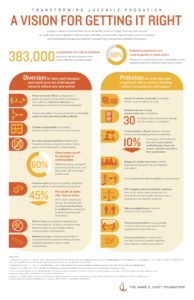Each year nearly 400,000 youth find themselves within the juvenile justice system. While juvenile arrests and detentions are trending downward, California’s rate of juvenile arrest and detention exceed those overall in the U.S. More than 86,000 juveniles are arrested in California each year.

A new report from the Annie E. Casey Foundation lays out a big vision for transforming and modernizing juvenile justice with an eye to getting better outcomes for the young people in our communities.
The report is based on 25 years of experience with the Foundation’s Juvenile Detention Alternatives Initiative, a project in over 300 counties nationwide aimed at reducing the number of detained youth, and five years of studying juvenile probation practices across the system. The report focuses specifically on transforming probation for young people because probation plays an outsized role for dealing with adolescents, and it has a pivotal impact on the life outcomes for youth.
The report’s good news is that evidence about intervention strategies and new knowledge about adolescent brain development and behaviors can be used to equip the justice system to do a better job for juvenile offenders in our community.
The Foundation’s recommendations call for diverting more cases away from formal court processing, and reshaping probation into an effective intervention program.
Research indicates typical surveillance-oriented probation for low-risk youth is not effective in solving delinquent behavior, and that probation often pulls young people deeper into the system. In many jurisdictions more youth are committed to residential facilities after some minor technical violation of probation than because of subsequent law-breaking behavior.
Probation for Youth Is Not Working
In the last 20 years, juvenile courts have decreased the use of incarceration in favor of probation. On the upside, probation offers youth the opportunity to stay in the community and participate in constructive activities, but on the downside probation doesn’t offer the support and guidance most youth need to reduce the likelihood of reoffending.
Probation can often pull youth deeper into the system because authorities frustrated by non-compliant behavior turn to confinement as a solution for technical violations, even though the young person that doesn’t pose a risk to public safety.
The vast majority of juvenile offenders ultimately grow out of delinquent behavior, making a strong case for diversion as a go-to strategy. Juvenile probation is often focused on “fixing” adolescents so they won’t break laws, rather than on helping young people build the skills they need to mature.
Future Vision for Juvenile Offenders
The report encourages counties and courts to take a two-pillar approach to transforming juvenile justice: Diversion for most youth, and a new kind of probation for those youth with a significant risk for serious offending without support and guidance to keep them on track.
Juvenile Diversion Recommendations
Low risk youth are 45% less likely to reoffend than comparable youth facing formal court processing, according to the report. Given the potential impact of diversion done right, the default should be diversion, not probation:
- Prosecutors and judges should use diversion as the default option for misdemeanors and first-time nonviolent offenders.
- Divert youth of color and white youth equitably.
- Divert more youth to community service.
- Refrain from court-imposed consequences for noncompliance.
- Transfer responsibility for diversion programming to non-court community partners.
- Consider options such as restorative justice, warnings, and individualized diversion plans.
A New Kind of Juvenile Probation
Low-risk youth placed on probation suffer a reoffending rate of up to 50%, according to the research. Those who were diverted from court were far less likely to reoffend. Evidence suggests support, not surveillance, nurturing maturity, and incentives for good behavior all help youth far more than the current practice of focusing on inhibiting delinquent behavior.
The Foundation’s vision for those needing probation is one of support and guidance, and includes:
- Eliminating standardized list of conditions. Some youth have to manage over 30 conditions of probation.
- Engage family and youth in setting expectations and make goals attainable and realistic.
- Offer proportional and targeted responses when expectations or short-term goals are not met. Minimize confinement as the default alternative.
- Focus probation officers time on nurturing maturity and skills in developing positive relationships.
- Provide positive incentives and recognition for achievement.
In November of 2017, Los Angeles County Board of Supervisors announced a sweeping juvenile diversion initiative, in which the county aims to steer 80% of the county’s arrests each year away from the juvenile court system and into supportive community support services. The Office of Youth Diversion and Development is working to create partnerships with law enforcement agencies in order to promote the use of diversion and to assess and serve youth placed in diversion programs.
Get a copy of the full report, Transforming Juvenile Probation: A Vision for Getting It Right, at the Annie E Casey Foundation website. http://www.aecf.org/resources/transforming-juvenile-probation/
David A. Stein is skilled criminal defense attorney with a track record of obtaining very successful outcomes for his clients. Get a no-cost consultation on any juvenile justice matter, including sealing juvenile records or expunging your record. Call 949-445-0040 today or contact us online by email here.
